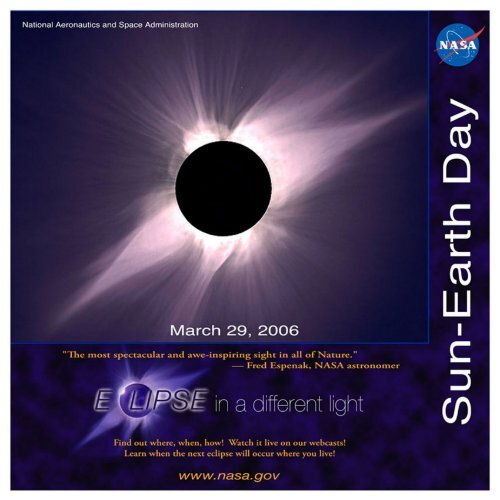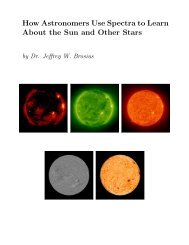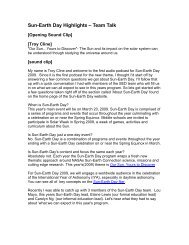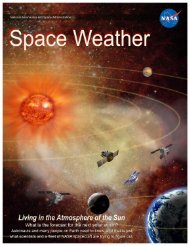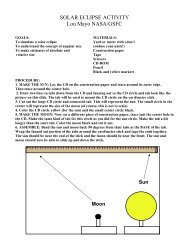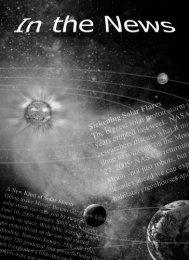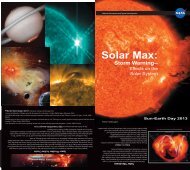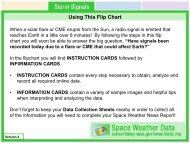Eclipse Basics - Sun-Earth Days 2013 - NASA
Eclipse Basics - Sun-Earth Days 2013 - NASA
Eclipse Basics - Sun-Earth Days 2013 - NASA
You also want an ePaper? Increase the reach of your titles
YUMPU automatically turns print PDFs into web optimized ePapers that Google loves.
<strong>Eclipse</strong> <strong>Basics</strong><br />
The Moon orbits <strong>Earth</strong> once every 29 days with respect to the <strong>Sun</strong>. During this period, the Moon<br />
undergoes all its familiar phases: new, first quarter, full, last quarter and back to new. During the new phase, the<br />
Moon passes between the <strong>Sun</strong> and <strong>Earth</strong> so the Moon’s side illuminated by sunlight is turned away from <strong>Earth</strong>.<br />
This means that we cannot see the Moon in the new phase.<br />
The Moon’s orbit is tilted slightly compared to <strong>Earth</strong>’s orbit around the <strong>Sun</strong>. As a consequence, the Moon<br />
usually passes a little above or below the <strong>Sun</strong> at most new moons. On rare occasions, the <strong>Sun</strong>, Moon and <strong>Earth</strong><br />
line up at new moon phase so that some portion of the Moon’s shadow falls onto <strong>Earth</strong>’s surface. At that time,<br />
the Moon is seen to pass across the <strong>Sun</strong> and we experience an eclipse of the <strong>Sun</strong>.<br />
Most people think that solar eclipses are quite rare but there are actually two to five eclipses every year.<br />
They only seem rare<br />
because each eclipse<br />
can only be seen from a<br />
small part of <strong>Earth</strong>.<br />
The next total<br />
solar eclipse visible in<br />
North America will not<br />
occur until 2017. The<br />
next total solar eclipse<br />
anywhere will be March<br />
29, 2006 with the path<br />
of totality crossing the<br />
Illustration of where the Moon’s shadow falls during an eclipse. Observers on<br />
<strong>Earth</strong> will see a different kind of eclipse depending on what part of<br />
the Moon’s shadow falls on them.<br />
west coast of Brazil,<br />
North Atlantic, Africa,<br />
and the Middle East.<br />
The Geometry of Solar <strong>Eclipse</strong>s<br />
Solar eclipses can only occur during new moon phase and only when the Moon’s shadow falls upon <strong>Earth</strong>.<br />
This shadow is actually composed of two parts. The penumbra is the pale, outer shadow where only part of the<br />
<strong>Sun</strong> is eclipsed. The umbra is the Moon’s dark, inner shadow where the <strong>Sun</strong>’s light is completely blocked. The<br />
diagram above (not drawn to scale) illustrates the geometry of eclipses caused by the Moon’s two shadows.<br />
There are three general classes of solar eclipses (as observed from any particular point on <strong>Earth</strong>):<br />
• Partial Solar <strong>Eclipse</strong>s occur when the penumbra of the Moon’s shadow passes over a region on <strong>Earth</strong>’s<br />
surface. A viewer sees only a portion of the <strong>Sun</strong> blocked by the Moon.<br />
• Total Solar <strong>Eclipse</strong>s occur when the umbra of the Moon’s shadow touches a region on the surface of<br />
<strong>Earth</strong>. The <strong>Sun</strong>’s bright disk is completely hidden from view.<br />
• Annular Solar <strong>Eclipse</strong>s occur when a region on <strong>Earth</strong>’s surface is in line with the umbra, (like a total<br />
eclipse) but the Moon appears too small to completely cover the <strong>Sun</strong>. This happens because the Moon’s orbit<br />
around <strong>Earth</strong> is an ellipse. As the Moon’s distance from <strong>Earth</strong> changes, so does its apparent size.<br />
At a partial eclipse, the Moon covers only a portion of the <strong>Sun</strong>’s bright disk. In comparison, the <strong>Sun</strong>’s<br />
disk is completely covered by the Moon at a total eclipse. Finally, the Moon covers the center of the <strong>Sun</strong>’s disk<br />
during an annular eclipse, but the outer edge of the <strong>Sun</strong> remains visible as a bright ring (as shown in the photo<br />
series at the top of this poster).<br />
A total eclipse can only be seen from within the narrow track of the Moon’s umbra as it crosses <strong>Earth</strong>’s<br />
surface. This path of totality is rarely more than 170 miles wide. Similarly, an annular eclipse can only be<br />
seen within the narrow track of the Moon’s umbra. This path of annularity is rarely more than 230 miles wide.<br />
Outside the path of either a total or annular eclipse, the Moon’s penumbra produces a broad band about 4000<br />
miles wide where a partial eclipse can be seen.
Photo from space of the Moon’s shadow striking <strong>Earth</strong> during an eclipse<br />
How often do eclipses occur There<br />
will be 36 solar eclipses from 2001-2025<br />
of which 15 will be total eclipses on some<br />
part of <strong>Earth</strong>’s surface – a little less than the<br />
average of about one a year. The common<br />
myth that eclipses don’t occur very often<br />
has evolved because seeing a total eclipse<br />
from a specific point on the surface of <strong>Earth</strong><br />
is not common.<br />
Experiencing a Total Solar<br />
<strong>Eclipse</strong><br />
Every total eclipse begins with a<br />
partial eclipse in which the Moon gradually<br />
covers more and more of the <strong>Sun</strong>’s disk. It<br />
usually takes about an hour for the Moon to<br />
completely cover the <strong>Sun</strong> before the start of<br />
the total phase or totality. During most of this time, the <strong>Sun</strong> and sky remain remarkably bright so that you would<br />
never know an eclipse was happening.<br />
In the last minutes before totality, events occur at an accelerated pace. The sky in the direction of the<br />
Moon’s shadow grows dark like an approaching thunderstorm. <strong>Sun</strong>light shining through tree leaves reveals a<br />
series of crescent shapes on the ground below. Shadows take on an odd sharpness and daylight appears weak<br />
and grey.<br />
In the final seconds, the Moon’s dark shadow rises above the horizon like a curtain rushing towards you.<br />
The <strong>Sun</strong>’s remaining crescent breaks up into a series of brilliant points along one rim of the Moon. These<br />
Baily’s beads are caused by sunlight shinning through deep valleys along the edge of the Moon. The last flash of<br />
light as the <strong>Sun</strong> disappears behind the Moon gives the appearance of a diamond. At the same instant, the <strong>Sun</strong>’s<br />
ghostly white corona encircles the Moon forming the so-called diamond ring effect.<br />
As totality begins, the solar corona (extended outer atmosphere of the <strong>Sun</strong>) blazes into view. The corona<br />
is a million times fainter than the surface of the <strong>Sun</strong>. It is only visible when a total eclipse blocks the <strong>Sun</strong>’s<br />
brilliant disk from view. The sky is now an eerie twilight that is dark enough to see the planets and the brighter<br />
stars. Sometimes ruby red prominences can be seen along the edge of the <strong>Sun</strong>. These are huge clouds of<br />
hydrogen gas that are larger than <strong>Earth</strong>. Animals often behave as if night has fallen and the temperature can drop<br />
15 degrees F.<br />
The period of totality rarely lasts more than a few minutes (about seven minutes maximum). The Moon’s<br />
disk begins to uncover the <strong>Sun</strong> as totality ends. Baily’s beads and the diamond ring are seen once again as the<br />
corona fades from view and daylight returns.<br />
A total eclipse is the most spectacular and awe-inspiring sight in all of Nature. Once seen it will never be<br />
forgotten. If you ever have an opportunity to observe a total solar eclipse, don’t miss it!<br />
Credit: Centre National d’Etudes Spatiales<br />
About the eclipse photo on the front side: This 1991 photograph captures the brief moment of totality when the <strong>Sun</strong>’s faint corona is<br />
most easily observed. It is made up of several photographs from cameras with different settings that were later combined into one image.<br />
Credit: Steve Albers, Dennis di Cicco, and Gary Emerson.
Credit: Fred Espenak<br />
The Baily’s Beads effect is seen here as sunlight begins to peek through<br />
valleys on the Moon just before or after a total solar eclipse<br />
Observing <strong>Eclipse</strong>s<br />
It is never safe to look at a partial or annular eclipse, or the partial phases of a total eclipse, without proper<br />
equipment and techniques. The lens in your eye can focus the <strong>Sun</strong>’s rays just like a magnifying glass. This can<br />
cause permanent eye damage or blindness. Since the eye’s<br />
retina has no pain sensors, you might not even know it’s<br />
happening! Please be very careful and use safe techniques for<br />
viewing the <strong>Sun</strong>.<br />
The projection technique is a simple and safe way to<br />
watch an eclipse. It requires two pieces of stiff white cardboard<br />
about 8” x 10” in size. Use a straight pin to make a small hole<br />
in the center of one piece of cardboard called the projector<br />
board. The second piece is the screen board. Hold up the<br />
projector board (with pinhole) so that its shadow falls onto<br />
the screen board. You will see a small image of the <strong>Sun</strong> safely<br />
projected onto the screen board. Try using a distance of 2-<br />
3 feet between the two boards. The larger this distance, the<br />
bigger the <strong>Sun</strong>’s image will be.<br />
If you own a pair of solar viewing glasses (sold for less<br />
than $2.00), you can safely view an eclipse with these. Or<br />
you could use solar projecting products like sunspotters or<br />
solarscopes. Or even a telescope with an approved solar filter.<br />
If you have some shade trees in your location, try looking<br />
at the images of the sun coming through the holes that are<br />
formed by the leaves and projected onto the ground (see image<br />
above). A piece of white poster board is handy to have for great<br />
viewing.<br />
Light filtering through leaves on trees casts circular<br />
shadows during an annular eclipse in May 1994<br />
Credit: Ruth Benn
The March 29, 2006 Total <strong>Eclipse</strong><br />
There will be a total eclipse on March 29, 2006. The path of totality begins in Brazil and extends across<br />
the South Atlantic Ocean, through Africa, and into Asia. It appears on the map below as the narrow pair of blue<br />
lines with small red circles in between. The red lines labeled 0.80, 0.60, 0.40 and 0.20 show the areas where a<br />
partial eclipse can be seen. The numbers indicate the fraction of the <strong>Sun</strong>’s diameter eclipsed. The further one<br />
travels from the path of totality, the smaller the partial eclipse. The longest period of totality will be just over<br />
four minutes. The next total solar eclipse after this will occur on August 1, 2008, and will be visible from northern<br />
Canada, Greenland, and central Asia.<br />
NP-2005-9-724-GSFC<br />
UT = Universal Time.<br />
Subtract 5 hours to get EST.<br />
Did You Know<br />
• An eclipse of the <strong>Sun</strong> is only possible when the Moon is new.<br />
• If the Moon’s orbit was not tilted, we would have an eclipse every month.<br />
• Total solar eclipses occur about once every 1 to 2 years.<br />
• The path of each eclipse begins at sunrise and ends at sunset about half way around the world.<br />
• Scientists can predict eclipses thousands of years into the past and future.<br />
For additional educational resources, go to: http://sunearthday.nasa.gov/
Partial solar eclipse at sunset -- from this viewer’s perspective the Moon will only cover a portion of the <strong>Sun</strong><br />
As the <strong>Sun</strong> begins to emerge from behind the Moon, a brightening on the Moon’s edge creates the “diamond ring” effect<br />
Credit: Fred Bruenjes<br />
©1998 by Fred Espenak<br />
Credit: Fred Espenak<br />
A photographer is captured as he watches a total solar eclipse at sunset at Antarctica in 2003.<br />
The eclipsed sun appears oval due to atmospheric effects


